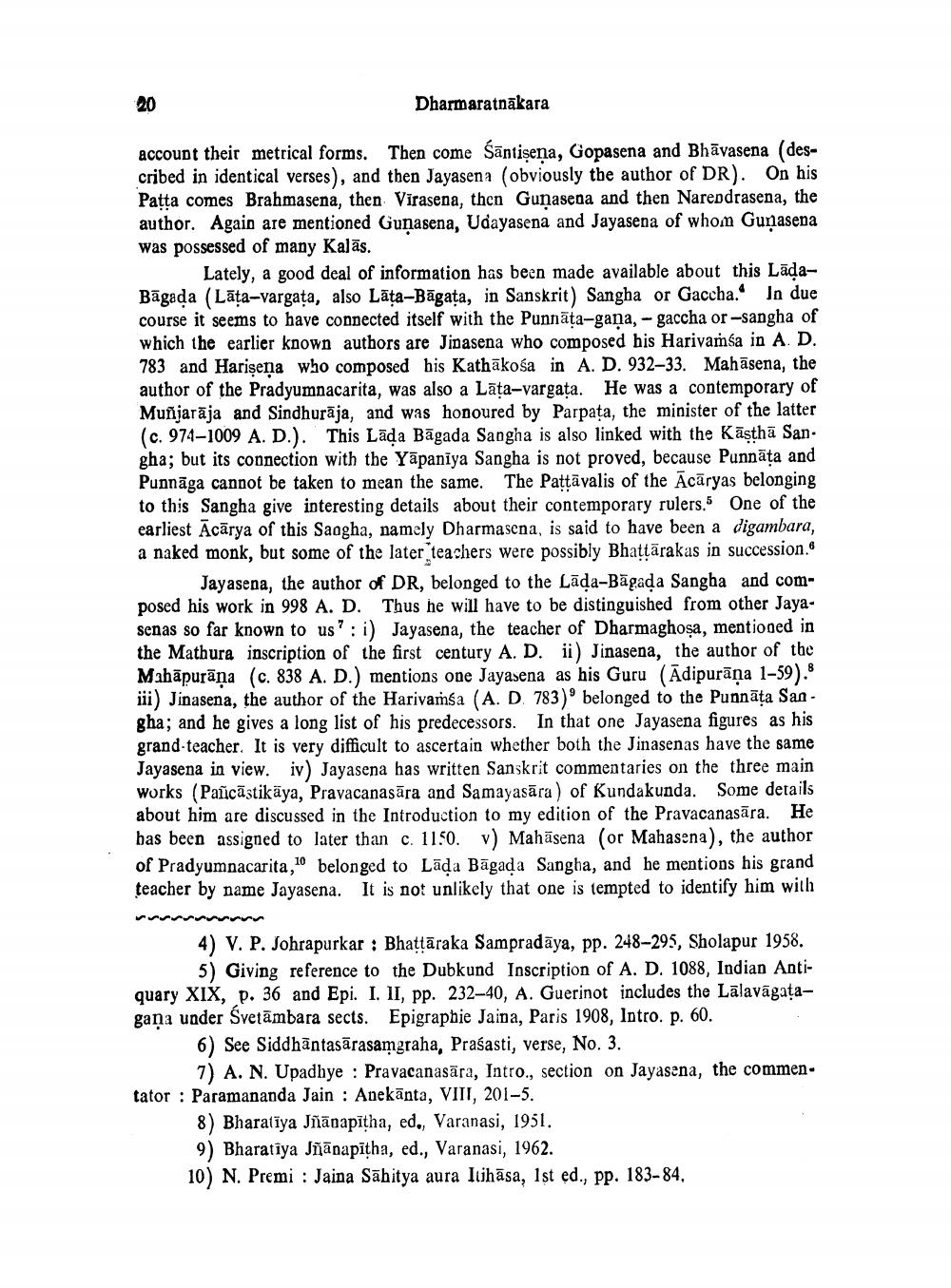________________
Dharmaratnākara
account their metrical forms. Then come śāntisena, Gopasena and Bhāvasena (described in identical verses), and then Jayasena (obviously the author of DR). On his Patta comes Brahmasena, then Virasena, then Gunasena and then Narendrasena, the author. Again are mentioned Gunasena, Udayasena and Jayasena of whom Gunasena was possessed of many Kalās.
Lately, a good deal of information has been made available about this LādaBāgada (Lāța-vargata, also Lāța-Bāgata, in Sanskrit) Sangha or Gaccha. In due course it seems to have connected itself with the Punnāta-gana, -gaccha or-sangha of which the earlier known authors are Jinasena who composed his Harivamsa in A. D. 783 and Harisena who composed bis Kathākośa in A. D. 932–33. Mahāsena, the author of the Pradyumnacarita, was also a Lāța-vargata. He was a contemporary of Muñjarāja and Sindhurāja, and was honoured by Parpata, the minister of the latter (c. 974-1009 A. D.). This Lāda Bāgada Sangha is also linked with the Kāsthā San. gha; but its connection with the Yāpanīya Sangha is not proved, because Punnāta and Punnāga cannot be taken to mean the same. The Pattāvalis of the Acāryas belonging to this Sangha give interesting details about their contemporary rulers. One of the earliest Acārya of this Saogha, namely Dharmasena, is said to have been a digambara, a naked monk, but some of the later teachers were possibly Bhattārakas in succession.
Jayasena, the author of DR, belonged to the Lāda-Bāgada Sangha and composed his work in 998 A. D. Thus he will have to be distinguished from other Jayasenas so far known to us?: i) Jayasena, the teacher of Dharmaghoșa, mentiooed in the Mathura inscription of the first century A. D. ii) Jinasena, the author of the Mahāpurāņa (c. 838 A. D.) mentions one Jayasena as his Guru (Adipurāņa 1-59). iii) Jinasena, the author of the Harivamsa (A. D. 783) belonged to the Punnāta Sangha; and he gives a long list of his predecessors. In that one Jayasena figures as his grand-teacher. It is very difficult to ascertain whether both the Jinasenas have the same Jayasena in view. iv) Jayasena has written Sanskrit commentaries on the three main works (Pascāstikäya, Pravacanasāra and Samayasāra) of Kundakunda. Some details about him are discussed in the Introduction to my edition of the Pravacanasāra. He bas been assigned to later than c. 1150. v) Mahāsena (or Mahasena), the author of Pradyumnacarita, 1 belonged to Lāda Bāgada Sangha, and he mentions his grand teacher by name Jayasena. It is not unlikely that one is tempted to identify him with
4) V. P. Johrapurkar : Bhattāraka Sampradāya, pp. 248-295, Sholapur 1958.
5) Giving reference to the Dubkund Inscription of A. D. 1088, Indian Antiquary XIX, p. 36 and Epi. I. II, pp. 232–40, A. Guerinot includes the Lālavāgatagaņa under Svetāmbara sects. Epigrapbie Jaipa, Paris 1908, Intro. p. 60.
6) See Siddhāntasārasamgraha, Prasasti, verse, No. 3.
7) A. N. Upadhye : Pravacanasāra, Intro., section on Jayasena, the commentator : Paramananda Jain : Anekānta, VIII, 201-5.
8) Bharatiya Jñānapītha, ed., Varanasi, 1951. 9) Bharatiya Jnānapītha, ed., Varanasi, 1962. 10) N. Premi : Jaina Sāhitya aura luhāsa, 1st ed., pp. 183-84,




